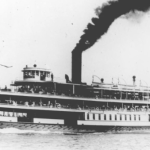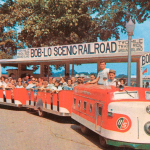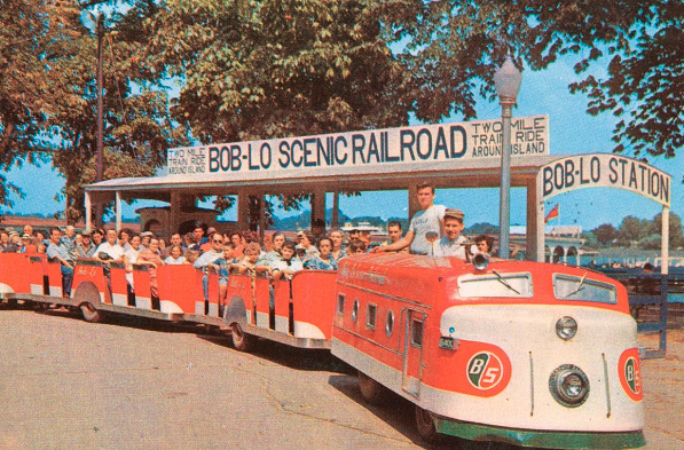An island park that stood the test of time for nearly a century, through two World Wars and the Great Depression, still holds a special place in thousands of Detroiter’s hearts. Bob-lo Island.
We at Detroitisit remember the island with great fondness as well, but Bob-Lo did go through some tumultuous times. So, we thought it would be interesting to take a look back at its history as summer 2023 draws to a close.
In 1898 the Detroit, Belle Isle & Windsor Ferry company signed a 15-year lease for 30 acres of Bois Blanc Island with an option to purchase the rest of the property at the end of the lease. John Scott, a Detroit architect, was hired to plan the site and develop a bicycle track, baseball diamond, bathing beach, bath-house, log cabin restaurant, boathouse, and casino.

PROMISE
On June 20th, 1898 the park officially opened, and 3,500 individuals boarded the steamer, Promise, which ran between Detroit, Amherstburg, and Bois Blanc, with excursions having been booked through the end of that year. Shortly after, steamer Scotia was acquired to run the Bois Blanc-Amherstburg route.
In 1901 D.B.I. & Windsor Ferry Company purchased 119 more acres to own nearly the entire island.
In 1902 the first of its two most famous steamers, the 216-foot Columbia with three decks and a dance floor, was built and placed on the Detroit – Bois Blanc route, making its one hour and twenty-minute maiden voyage on July 7th.

SS COLUMBIA
Her sister ship, the Ste. Claire, was built in Toledo in 1910, making her maiden voyage on July 11th of that year.
The next two decades would bring a new cut-stone and steel pavilion, a dance floor, new amusement rides, Shetland ponies, Vernor’s Ginger Ale plants, a coaster ride, a Ferris wheel, and more.
The park then closed for two years in 1933 and 1934 due to economic issues caused by the Great Depression.
In 1939 D.B.I. & Windsor Ferry Company changed its name to Bob-Lo Excursion Company.
In 1940 ferry service between Bob-Lo and Amherstburg was again withdrawn due to World War II border regulations and remained this way until 1947.
In 1945, a 24-year-old African American woman named Sarah Elizabeth Ray was removed from the Columbia due to the color of her skin. The ferry company had a rule excluding “Zoot-suiters, the rowdyish, the rough, the boisterous . . . and colored.”
Ultimately, the State of Michigan brought a racial discrimination case against the operators of Bob-Lo Excursion Company. After Michigan found Bob-Lo guilty and fined the company, Bob-Lo filed a lawsuit against the state, Bob-Lo Excursion Co. v. Michigan, 333 U.S. 28 (1948). The case reached the U.S. Supreme Court and on February 2, 1948, the Supreme Court affirmed the rulings of the lower courts and found guilty against Bob-Lo.
In early 1949, the assets of the Bob-Lo Excursion Company would be sold to Browning Steamship Lines of Detroit.
For the next thirty years, the amusement park flourished. In 1958 a scenic railway was built. Several new rides were added along with a marina.

SCENIC RAILWAY
In 1979 the Brownings sold to a seven-member American syndicate and the Big Wheel ride was added shortly after. But by 1982 the park was in financial trouble. It was purchased in 1983 by Michigan AAA for $6.5 million. For the next five years, the park would expand and the 1906 carousel was restored.
In 1988 the park again changed hands and went to the International Broadcasting Company for $21 million. But the park had seen better days. Larger amusement parks such as Cedar Point and Great America became more popular, and attendance began to decline. During the 1990 season, the park was closed on Tuesdays in an effort to save money. In the fall of 1991 Steamers Columbia and Ste. Claire made their last trip from Detroit to Bob-Lo on Labor Day. The park declared bankruptcy that Fall.
There would be one more season under Seattle-based Northern Capital Company. In 1993 the bank fell into receivership and was auctioned off piece by piece the following spring.
In August of 1994, Bob-Lo Island was sold a final time to John Oram, who subdivided it into lots for residential housing. Little has been developed.
And so goes the story of an iconic island park that gave Detroiters and Canadians many memories. We can only imagine how many more could be made on that island of fun between two countries!
As always, be sure to subscribe to our newsletter for regular updates on all things Detroit.






















